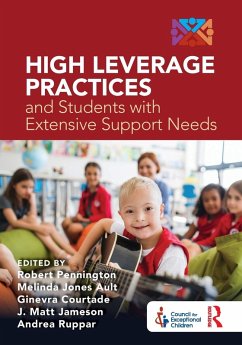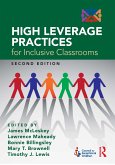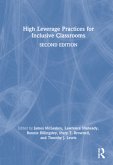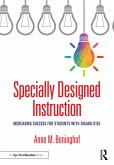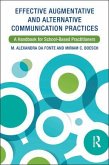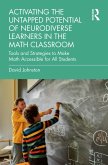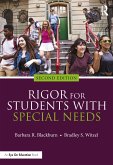High Leverage Practices and Students with Extensive Support Needs
Herausgeber: Pennington, Robert; Courtade, Ginevra; Ault, Melinda Jones
High Leverage Practices and Students with Extensive Support Needs
Herausgeber: Pennington, Robert; Courtade, Ginevra; Ault, Melinda Jones
- Broschiertes Buch
- Merkliste
- Auf die Merkliste
- Bewerten Bewerten
- Teilen
- Produkt teilen
- Produkterinnerung
- Produkterinnerung
Building on the formative work of High Leverage Practices for Inclusive Classrooms, this critical companion explores how high leverage practices can be applied to the education of students with extensive support needs (ESN).
Andere Kunden interessierten sich auch für
![High Leverage Practices for Inclusive Classrooms High Leverage Practices for Inclusive Classrooms]() High Leverage Practices for Inclusive Classrooms32,99 €
High Leverage Practices for Inclusive Classrooms32,99 €![High Leverage Practices for Inclusive Classrooms High Leverage Practices for Inclusive Classrooms]() High Leverage Practices for Inclusive Classrooms152,99 €
High Leverage Practices for Inclusive Classrooms152,99 €![Specially Designed Instruction Specially Designed Instruction]() Anne M. BeninghofSpecially Designed Instruction32,99 €
Anne M. BeninghofSpecially Designed Instruction32,99 €![Effective Augmentative and Alternative Communication Practices Effective Augmentative and Alternative Communication Practices]() M. Alexandra Da FonteEffective Augmentative and Alternative Communication Practices35,99 €
M. Alexandra Da FonteEffective Augmentative and Alternative Communication Practices35,99 €![Activating the Untapped Potential of Neurodiverse Learners in the Math Classroom Activating the Untapped Potential of Neurodiverse Learners in the Math Classroom]() David JohnstonActivating the Untapped Potential of Neurodiverse Learners in the Math Classroom31,99 €
David JohnstonActivating the Untapped Potential of Neurodiverse Learners in the Math Classroom31,99 €![Rigor for Students with Special Needs Rigor for Students with Special Needs]() Barbara R. Blackburn (USA Blackburn Consulting Group)Rigor for Students with Special Needs41,99 €
Barbara R. Blackburn (USA Blackburn Consulting Group)Rigor for Students with Special Needs41,99 €![Essentials of Special Education Essentials of Special Education]() Catherine Lawless Frank (USA University of Dayton)Essentials of Special Education57,99 €
Catherine Lawless Frank (USA University of Dayton)Essentials of Special Education57,99 €-
-
-
Building on the formative work of High Leverage Practices for Inclusive Classrooms, this critical companion explores how high leverage practices can be applied to the education of students with extensive support needs (ESN).
Produktdetails
- Produktdetails
- Verlag: Taylor & Francis Ltd
- Seitenzahl: 278
- Erscheinungstermin: 21. November 2022
- Englisch
- Abmessung: 254mm x 178mm x 15mm
- Gewicht: 520g
- ISBN-13: 9780367772550
- ISBN-10: 0367772558
- Artikelnr.: 64678387
- Herstellerkennzeichnung
- Libri GmbH
- Europaallee 1
- 36244 Bad Hersfeld
- gpsr@libri.de
- Verlag: Taylor & Francis Ltd
- Seitenzahl: 278
- Erscheinungstermin: 21. November 2022
- Englisch
- Abmessung: 254mm x 178mm x 15mm
- Gewicht: 520g
- ISBN-13: 9780367772550
- ISBN-10: 0367772558
- Artikelnr.: 64678387
- Herstellerkennzeichnung
- Libri GmbH
- Europaallee 1
- 36244 Bad Hersfeld
- gpsr@libri.de
Robert Pennington is the Lake & Edward J. Snyder, Jr. Distinguished Professor in Special Education at University of North Carolina-Charlotte, USA. Melinda Jones Ault is a Professor at University of Kentucky, USA. Ginevra Courtade is a Professor at University of Louisville, USA. J. Matt Jameson is a Professor at University of Utah, USA. Andrea Ruppar is an Associate Professor at University of Wisconsin-Madison, USA.
1. Collaborate with Colleagues to Increase Student Success 2. Leading
Effective Meetings with Professionals and Families 3. Collaborate with
Families to Support Student Learning and Needed Services 4. Using Multiple
Sources of Information to Develop a Comprehensive Understanding of a
Student's Strengths and Needs 5. Interpreting and Communicating Assessment
Information with Stakeholders to Collaboratively Design and Implement
Educational Programs 6. Using Student Assessment Data, Analyzing
Instructional Packages, and Making Necessary Adjustments that Improve
Student Outcomes 7. Consistent, Organized, and Respectful Learning
Environment 8. Using Feedback to Improve Student Outcomes 9. Teaching
Social Skills 10. Conducting Functional Behavior Assessment to Develop
Individualized Behavior Support Plans 11. Identify and Prioritize Long- and
Short-term Learning Goals 12. Systematically Design Instruction toward a
Specific Learning Goal 13. Adapt Curriculum Tasks and Materials for
Specific Learning Goals 14. Teaching Cognitive and Meta Cognitive
Strategies to Support Learning and Independence 15. Providing Scaffolded
Supports 16. Providing Intensive Instruction and Using Explicit Instruction
17. Using Flexible Grouping 18. Use Strategies to Promote Active Engagement
19. Use Assistive and Instructional Technologies 20. Teach Students to
Maintain and Generalize New Learning Across Time and Settings 21. Providing
Positive and Corrective Feedback
Effective Meetings with Professionals and Families 3. Collaborate with
Families to Support Student Learning and Needed Services 4. Using Multiple
Sources of Information to Develop a Comprehensive Understanding of a
Student's Strengths and Needs 5. Interpreting and Communicating Assessment
Information with Stakeholders to Collaboratively Design and Implement
Educational Programs 6. Using Student Assessment Data, Analyzing
Instructional Packages, and Making Necessary Adjustments that Improve
Student Outcomes 7. Consistent, Organized, and Respectful Learning
Environment 8. Using Feedback to Improve Student Outcomes 9. Teaching
Social Skills 10. Conducting Functional Behavior Assessment to Develop
Individualized Behavior Support Plans 11. Identify and Prioritize Long- and
Short-term Learning Goals 12. Systematically Design Instruction toward a
Specific Learning Goal 13. Adapt Curriculum Tasks and Materials for
Specific Learning Goals 14. Teaching Cognitive and Meta Cognitive
Strategies to Support Learning and Independence 15. Providing Scaffolded
Supports 16. Providing Intensive Instruction and Using Explicit Instruction
17. Using Flexible Grouping 18. Use Strategies to Promote Active Engagement
19. Use Assistive and Instructional Technologies 20. Teach Students to
Maintain and Generalize New Learning Across Time and Settings 21. Providing
Positive and Corrective Feedback
1. Collaborate with Colleagues to Increase Student Success 2. Leading
Effective Meetings with Professionals and Families 3. Collaborate with
Families to Support Student Learning and Needed Services 4. Using Multiple
Sources of Information to Develop a Comprehensive Understanding of a
Student's Strengths and Needs 5. Interpreting and Communicating Assessment
Information with Stakeholders to Collaboratively Design and Implement
Educational Programs 6. Using Student Assessment Data, Analyzing
Instructional Packages, and Making Necessary Adjustments that Improve
Student Outcomes 7. Consistent, Organized, and Respectful Learning
Environment 8. Using Feedback to Improve Student Outcomes 9. Teaching
Social Skills 10. Conducting Functional Behavior Assessment to Develop
Individualized Behavior Support Plans 11. Identify and Prioritize Long- and
Short-term Learning Goals 12. Systematically Design Instruction toward a
Specific Learning Goal 13. Adapt Curriculum Tasks and Materials for
Specific Learning Goals 14. Teaching Cognitive and Meta Cognitive
Strategies to Support Learning and Independence 15. Providing Scaffolded
Supports 16. Providing Intensive Instruction and Using Explicit Instruction
17. Using Flexible Grouping 18. Use Strategies to Promote Active Engagement
19. Use Assistive and Instructional Technologies 20. Teach Students to
Maintain and Generalize New Learning Across Time and Settings 21. Providing
Positive and Corrective Feedback
Effective Meetings with Professionals and Families 3. Collaborate with
Families to Support Student Learning and Needed Services 4. Using Multiple
Sources of Information to Develop a Comprehensive Understanding of a
Student's Strengths and Needs 5. Interpreting and Communicating Assessment
Information with Stakeholders to Collaboratively Design and Implement
Educational Programs 6. Using Student Assessment Data, Analyzing
Instructional Packages, and Making Necessary Adjustments that Improve
Student Outcomes 7. Consistent, Organized, and Respectful Learning
Environment 8. Using Feedback to Improve Student Outcomes 9. Teaching
Social Skills 10. Conducting Functional Behavior Assessment to Develop
Individualized Behavior Support Plans 11. Identify and Prioritize Long- and
Short-term Learning Goals 12. Systematically Design Instruction toward a
Specific Learning Goal 13. Adapt Curriculum Tasks and Materials for
Specific Learning Goals 14. Teaching Cognitive and Meta Cognitive
Strategies to Support Learning and Independence 15. Providing Scaffolded
Supports 16. Providing Intensive Instruction and Using Explicit Instruction
17. Using Flexible Grouping 18. Use Strategies to Promote Active Engagement
19. Use Assistive and Instructional Technologies 20. Teach Students to
Maintain and Generalize New Learning Across Time and Settings 21. Providing
Positive and Corrective Feedback

